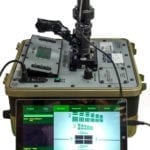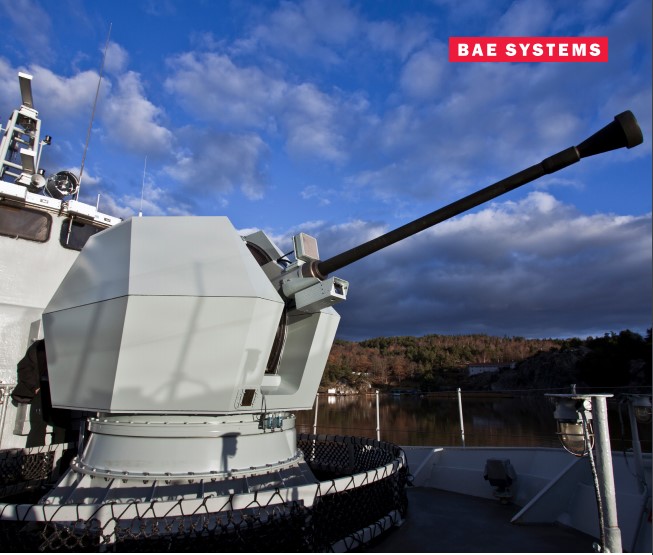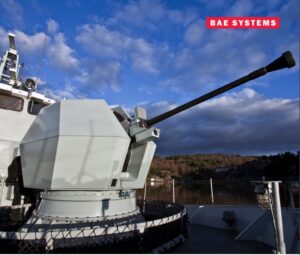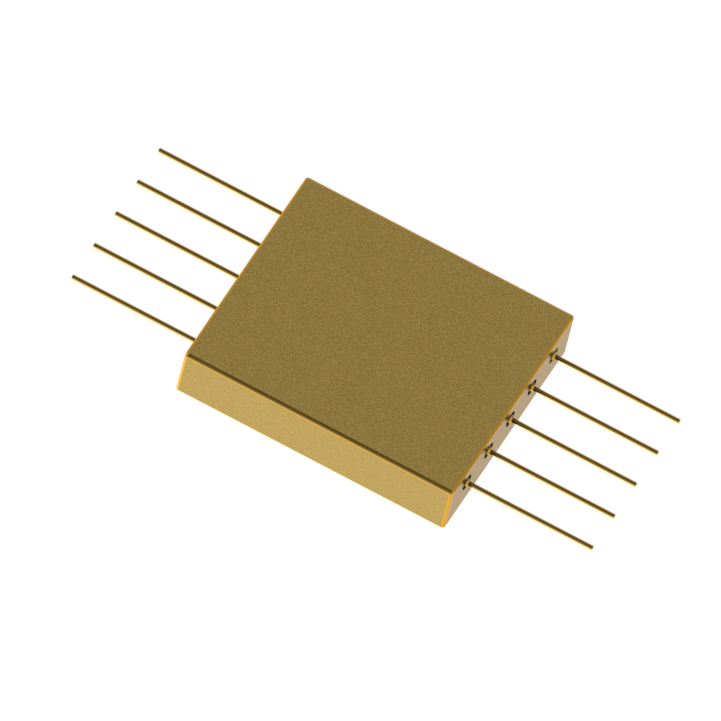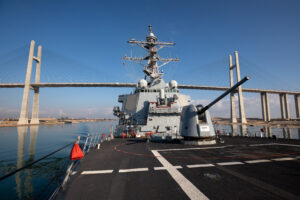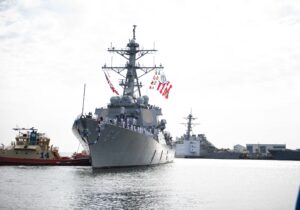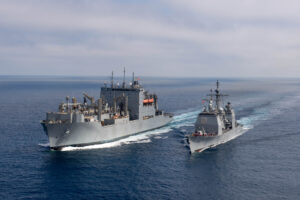Welding School. The Navy’s Submarine Industrial base program announced the opening of the John D. Haynes School of Welding Technology at Mount Vernon High School on Oct. 24 to help improve on the shortage of naval shipbuilders and tradespeople. This is a collaboration between BWX Technologies and BlueForge Alliance. The Navy said this school will provide students the chance to both complete their high school diploma and a welding certification, with graduates getting a direct entry to BWXT’s nuclear operations group. The school will be able to accommodate up to 60 students per year. The Navy called this a potential blueprint for similar programs across the country with government, industry and academia cooperating to bolster the defense industrial base workforce.
Naval Strategic Studies Group.
The Department of the Navy (DoN) said in January 2025 it will establish a Naval Strategic Studies Group (NSSG) program to be administered by the DoN Office of Strategic Assessment (OSA). NSSG is being modeled after the Cold War-era Strategic Studies Group that trained future flag officers in strategic thinking and conducted research on strategic challenges. The first cohort of the new group will be Navy and Marine Corps members conducting a capstone research project related to the strategic elements of Secretary of the Navy Carlos Del Toro’s maritime statecraft initiative. The secretary established OSA in October 2023 and has tasked them with reconstituting this NSSG program to “rebuild the naval strategist community,” the service said.
Bomber Task Force-Europe. U.S. Air Force Global Strike Command (AFGSC) has conducted more than a half dozen Bomber Task Forces (BTFs) so far this year, and another will occur in Europe within days to practice with NATO allies for several weeks, AFGSC said on Friday. In August and September, 180 personnel from the 110th Expeditionary Bomb Squadron and three B-2 Spirit stealth bombers from Whiteman AFB, Mo., deployed with the Royal Australian Air Force (RAAF) to conduct 34 sorties with other aircraft, including F-35s, E-7 Wedgetails, and EA-18G Growler jamming aircraft. AFGSC said that B-2 aircrews communicated with Air Force joint terminal attack controller “forward observers” and RAAF Marine Rotational Force-Darwin for inert bombing runs.
…B-1s. U.S. Air Forces Europe did not specify the number or type of bombers that will deploy to Europe for the coming BTF. The Air Force has used all its bomber types–B-52, B-1, and B-2–for BTFs, but the three types have not appeared in the same BTF. As part of BTF-2 in February, two B-1B Lancers from Ellsworth AFB, S.D.’s 28th Bomb Wing deployed to Luleå-Kallax Air Base, Sweden, to train with Swedish Air Force JAS 39 Gripen fighters in what marked the first multi-day deployment of U.S. bombers to Sweden.
Second SAOC. SNC said that the second 747-8i for the U.S. Air Force’s Survivable Airborne Operations Center (SAOC) program has arrived at the company’s Aviation Innovation and Technology Center (AITC) near Wright-Patterson AFB, Ohio. In April, SNC received an up to $13 billion Air Force award for SAOC, which is to replace the service’s Boeing E-4B “Nightwatch” fleet, based on the 747 passenger plane and used as a mobile national command authority in crisis situations, such as “doomsday” events. “Acceptance of the second [747-8i] aircraft – just six months after SAOC contract award in April 2024 – signifies substantial and swift progress on the vital program,” SNC said on Thursday. Work at AITC on “state-of-the-art” SAOC hangars for SAOC and other “large aircraft modernization modification projects” recently started, the company said.
C-390 Hybrid SATCOM. Viasat and Embraer said that they are teaming to give Embraer’s C-390 airlifter improved communications through Viasat’s Hybrid SATCOM Approach (HSA), based on the Ku/Ka-band GAT-5530 terminal. “The HSA will provide secure and reliable satellite connectivity to the C-390 aircraft with automated failover, enhancing operations with resilient broadband SATCOM supporting the operational flexibility and responsiveness required by the C-390 tactical mission,” the companies said. C-390s with HSA may be an option for the U.S. Air Force to supplement its C-130Js, particularly in the area of highest national security concern, the Indo-Pacific. Viasat and Embraer said that HSA will support communications “using Ku-band and WGS” and will provide “flexibility for installation of future mission communications systems in LEO and L-Band.”
Freedom’s Forge Redux. Amid widespread concerns that the defense industrial base is incapable of a rapid production increase to a wartime footing, the Defense Advanced Research Projects Agency in January will host an invitation-only workshop focused on a “sustained surge” of responsive, agile, flexible, and scalable advanced manufacturing. The workshop in Houston will help develop a new strategic pillar—Freedom’s Forge 2.0—led by DARPA’s Tactical Technology Office and inspired by transition of American industry to defense production in the early 1940s. “Key elements are rapid evolution from concept to manufacture and design to support surge production,” DARPA said in a notice last week. “Cost awareness and cost control of the manufactured articles are included in this focus area.”
…Hypothetical Challenge. Ahead of the Jan. 22-24 workshops, DARPA wants researchers, engineers, and subject matter experts to consider a hypothetical challenge involving the manufacture of an approximately 220-pound unmanned aircraft system that would have to be built at a rate of 100 units per day within five days of being ordered and can quickly be validated for meeting quality and functionality standards. The Oct. 28 notice provides examples of innovations that could solve the challenge, including using robots to shape digitally defined metal parts rather than using rigid molds, and additive manufacturing or digitally controlled machinating to rapidly produce molds and dies. DARPA wants the workshop to lead to a “strategy for technology advancement and investment in advanced manufacturing.”
The Faulty Welds. Faulty welds recently discovered by HII on aircraft carrier and submarine work it is doing for the Navy made up just a “small fraction” of the overall welds and were committed by a small number of welders at the company’s Newport News Shipbuilding facility, HII President and CEO Chris Kastner told investors last week. HII took an “immaterial” charge in the third quarter “for the cost that we think could be deemed unallowable” related to the faulty welds, Tom Stiehle, the company’s chief financial officer, said. Once the investigation is complete there will be “finality on the financial front,” Stiehle said. Kaster said the company is “working very closely with the customer to bound the issue.”
…Dividend Hike. HII’s third quarter results last week were fraught with problems stemming from delays in a potential 17-submarine contract, combined with labor and supply chain challenges. Those concerns more than outweighed the faulty weld issue, which has drawn concern from House defense overseers. Still, ahead of the financial release, HII said its board raised the quarterly cash dividend by nearly 4 percent to $1.35 per share from the current $1.30 payout. The new dividend rate will be payable on Dec. 13.
M&A Thoughts. Bill Lynn, chairman and CEO of Leonardo DRS, last week said the company’s top priority for capital deployment is acquisitions, adding that there is more “volume” on the mergers and acquisitions front now and “an uptick in actionable opportunities” in the core market areas it targets. These areas are advanced sensing, naval power, force protection, and network computing. “So, we’re very active in terms of diligence,” he said, adding, “nothing yet to announce.” Lynn also said the company does not have anything “actionable at this point” related to potential Boeing assets that may be on the market.
…AI Innovation. Touting his company’s innovation chops, Lynn also said Leonardo DRS has strengthened its radar sensing capabilities by developing and testing an “AI-aided target recognition capability on multiple platforms.” A Leonardo DRS spokesman later told Defense Daily that the company’s RADA business unit has built the artificial intelligence recognition capability into their radars to enable them “to de-prioritize” certain objects like birds to ignore non-threats.
Corporate News. Defense technology company BlueHalo last week said it has established a presence in Lawton, Okla., at the Fires Innovation Science and Technology Accelerator to better serve its Army customers at Fort Sill on counter-drone solutions and air defense training technologies. Australia’s DroneShield, a developer and provider of counter-unmanned aircraft systems (C-UAS), is expanding its European footprint appointing a team of counter-drone professionals in Denmark and Germany to provide local engagement and support. Germany’s Rohde & Schwarz has launched ARDRONIS Detect, a compressive C-UAS solution for detecting, localizing, and identifying drones. R&S said ARDRONIS can be deployed in fixed, semi-mobile, and mobile configurations.
People News. Former Republican Congressman and CIA veteran Will Hurd (Texas) has joined defense technology company CHAOS Industries as chief strategy officer. CHAOS, a venture capital-backed Los Angeles-based startup, has developed a dual-use, multistatic commercial radar for early warning and tracking of small drones, to missiles, and fighter jets. MITRE has named Katie Schroth as vice president of the Air and Space Forces Center, which provides technical capabilities for the Air Force. Voter Space has appointed Matt Magana as executive vice president for national security. Magana was previously president and CEO of RTX’s Blue Canyon Technologies satellite business. Finally, Maxar Intelligence has appointed Matt Santangelo as chief financial officer and Matt Jenkins as chief space systems officer. Santangelo was most recently CFO of the cybersecurity company Forcepoint and Jenkins was head of the engineering team at Amazon’s Project Kuiper.
Bacon’s Seat. The Cook Political Report, a non-partisan political analysis group, said on Nov. 1 in its final update ahead of Election Day that its outlook on Rep. Don Bacon’s (R-Neb) race to keep his seat representing Nebraska’s 2nd district has shifted from “toss up” to “lean Democrat.” Bacon, a member of the House Armed Services Committee, has been locked in a tight race against Democratic state senator Tony Vargas to represent the swing district. The group’s prediction gives Vargas the slight edge following recent favorable polling numbers for the Democrat. Bacon, who has held the seat since 2017, is a former brigadier general in the Air Force and has been a proponent of cyber and electronic warfare programs and efforts during his tenure on HASC.
New Rheinmetall JV. Germany’s Rheinmetall signed a memorandum of understanding on Oct. 28 to establish a new joint venture with Croatian firm DOK-ING that will focus on unmanned ground systems (UGS). Rheinmetall noted the new venture will include joint development and marketing for the new DOK-ING Komodo platform, with the German company set to provide capability modules and upgrade kits for direct and indirect fire, mine-laying, reconnaissance sensors, logistics and more “as well as its international market access and industrial capacities.” “DOK-ING and Rheinmetall represent two leading European suppliers in their field, joining forces to carry out challenging projects. Together, we aim to set new standards and pave the way for the series production and application of UGSs. We are addressing the European market as well as other partner nations,” Björn Bernhard, head of Rheinmetall’s vehicle systems Europe division, said in a statement.
Switzerland/Patriot Support. The State Department said on Oct. 28 it has approved a possible $450 million foreign military sale with Switzerland for equipment to sustain its Patriot air defense systems. The FMS case covers support for Switzerland’s five RTX Patriot systems and Lockheed Martin-built interceptor inventory, and includes test station equipment, Foreign Liaison Officer support, international engineering services, modification and upgrade kits, classified missile processing and spares. “The proposed sale supports Switzerland’s goal of maintaining national and territorial defense as well as interoperability with U.S. and other European forces,” the Defense Security Cooperation Agency said in a statement.
Argentina/F-16 Equipment. The State Department then said on Oct. 30 it has also approved a potential $941 million FMS case with Argentina for F-16 aircraft equipment and support. The deal would include 36 AIM-120 C-8 AMRAAM missiles, MK-82 500-pound bombs, weapons support equipment, AN/ARC-238 radios, Joint Mission Planning Systems, cryptographic devices, avionics support, communications equipment, electronic warfare database support, modifications and maintenance support, spare parts, jet fuel and logistics support services. “The proposed sale will improve Argentina’s capability to meet current and future threats by providing the additional capacity to conduct air defense, offensive counter air, and close air support operations,” the Defense Security Cooperation Agency said in a statement.
Poland FMS. The State Department on November 1 said it has also approved an FMS case with Poland for GCA-2020 Mobile Ground Control Approach Systems. The L3Harris military air traffic control radars consist of ultra high frequency radios, AN/UPX interrogators and radio navigation equipment and Poland will also receive test equipment. “The proposed sale will improve Poland’s capability to meet current and future threats by bolstering its capabilities in air traffic control and reinforcing its commitment to provide secure and effective aviation services in accordance with international norms, while expanding its national defense capabilities and supporting the common defense of NATO,” the Defense Security Cooperation Agency said in a statement.
Navy Radars. Leonardo DRS said on Nov. 1 it was recently awarded a new deal from the Navy worth up to $235 million to produce additional AN/SPQ-9B ship-based air and surface target detection radars. “The SPQ-9B radar is a vital ship protection system used across the fleet, and we are proud that the U.S. Navy continues to entrust us to produce this important defensive technology,” Cari Ossenfort, senior vice president and general manager of Leonardo DRS’ Naval electronics business unit, said in a statement. “Our experienced team’s ability to execute complex manufacturing and proven engineering processes are the key reasons we remain a trusted partner to NAVSEA and PEO Integrated Warfare Systems.” Leonardo DRS noted the SPQ-8 radars are used for “simultaneous and automatic air and surface target detection and tracking of low flying anti-ship cruise missiles, surface threats and low/slow flying aircraft, UAVs, periscopes and helicopters.”
